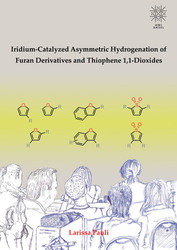| Departments | |
|---|---|
| Book Series (96) |
1378
|
| Nachhaltigkeit |
3
|
| Gesundheitswesen |
1
|
| Humanities |
2363
|
| Natural Sciences |
5406
|
| Mathematics | 229 |
| Informatics | 319 |
| Physics | 980 |
| Chemistry | 1363 |
| Geosciences | 131 |
| Human medicine | 243 |
| Stomatology | 10 |
| Veterinary medicine | 108 |
| Pharmacy | 147 |
| Biology | 835 |
| Biochemistry, molecular biology, gene technology | 121 |
| Biophysics | 25 |
| Domestic and nutritional science | 45 |
| Agricultural science | 1004 |
| Forest science | 201 |
| Horticultural science | 20 |
| Environmental research, ecology and landscape conservation | 148 |
| Engineering |
1791
|
| Common |
98
|
|
Leitlinien Unfallchirurgie
5. Auflage bestellen |
|
Advanced Search
Iridium-Catalyzed Asymmetric Hydrogenation of Furan Derivatives and Thiophene 1,1-Dioxides (English shop)
Larissa Pauli (Author)Preview
Table of Contents, PDF (88 KB)
Extract, PDF (400 KB)
The main focus of the research presented in this dissertation was to broaden the substrate scope of the iridium-catalyzed asymmetric hydrogenation of heterocyclic compounds. In view of the fact that a widely applicable hydrogenation system for the reduction of structurally diverse furans and benzofurans is to date not available, a thorough investigation of furan, benzofuran and thiophene 1,1-dioxide derivatives was carried out. Mono- and disubstituted furan derivatives were synthesized and submitted to iridium-catalyzed hydrogenation reactions. While 3-substituted furans were reduced using a catalyst based on a cyclopentane-annulated bicyclic pyridine-phosphine ligand with high enantiomeric excess (95–99% ee) and conversion (83–99%), 2-substituted counterparts proved to be less reactive (80–97% conv., 65–82% ee) with the same catalyst. Asymmetric hydrogenation of 2,4-disubstituted furans proved to be challenging for several reasons, not least because of the problem of controlling the cis/trans selectivity. Surprisingly, in the iridium-catalyzed hydrogenation of 3-substituted benzofurans only one catalyst, based on the cyclohexane-annulated pyridine-phosphinite ligand, showed high activity and enantioselectivity (75–89% conv., 91–92% ee), whereas the five-membered ring analog suffered from moderate activity and enantioselectivity. In contrast, the 2-alkyl substituted benzofurans gave superior results (99% conv., 97–99% ee). Disubstituted thiophene 1,1-dioxides were also investigated in the iridium-catalyzed asymmetric hydrogenation. The hydrogenation of 3,4 disubstituted thiophene 1,1 dioxides using a catalyst based on a cyclopentane-annulated bicyclic pyridine-phosphine ligand gave inferior results to those obtained with their 2,5 disubstituted counterparts.
| ISBN-13 (Hard Copy) | 9783954048519 |
| ISBN-13 (eBook) | 9783736948518 |
| Final Book Format | A5 |
| Language | English |
| Page Number | 178 |
| Lamination of Cover | matt |
| Edition | 1. Aufl. |
| Publication Place | Göttingen |
| Place of Dissertation | Basel |
| Publication Date | 2014-12-08 |
| General Categorization | Dissertation |
| Departments |
Chemistry
Organic chemistry |
| Keywords | asymmetric catalysis, furans, benzofurans, thiophene 1,1-dioxides, iridium, N,P ligands, hydrogenation |








